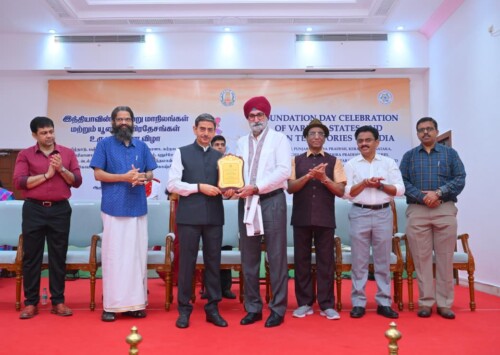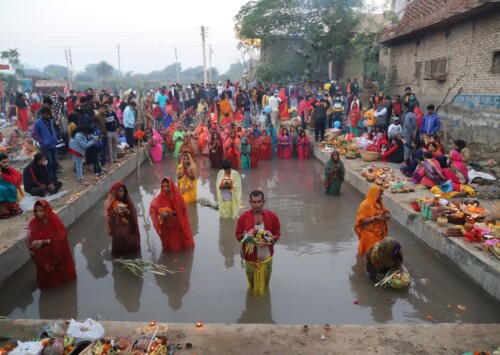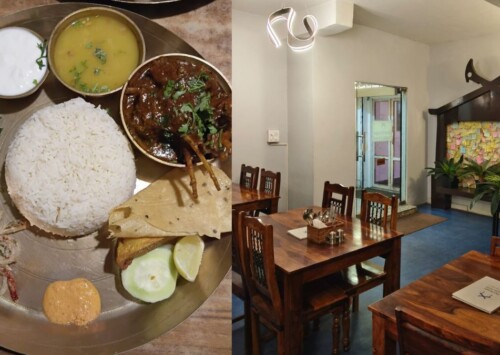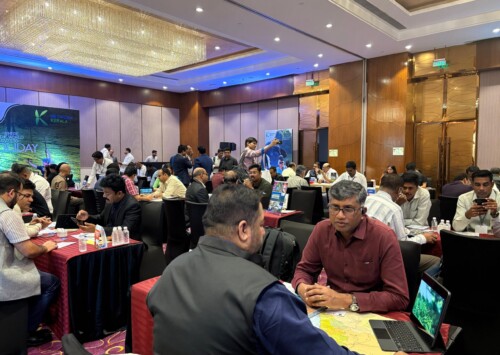Asia’s Largest Carpet Revives Kashmir’s Fading Craft

For nine long years, artisans poured their lives into a monumental piece, knot by knot, transforming delicate threads of silk into a embroidery of artistry and tradition
In the heart of Kashmir, 24 artisans spent nine years crafting Asia’s largest handmade silk carpet, a 267.5-square-metre masterpiece, blending tradition, resilience, and bringing hopes of revival for the Valley’s fading artistry.

For nine long years, artisans poured their lives into a monumental piece, knot by knot, transforming delicate threads of silk into a embroidery of artistry and tradition
As the handmade carpet industry in Kashmir faced a steady decline, a remarkable achievement sparked hope. Over nine years, 24 skilled artisans wove Asia’s largest handmade silk carpet, a 267.5-square-metre masterpiece. This extraordinary creation showcases the resilience and unparalleled craftsmanship of Kashmiri weavers, offering a beacon of revival for a centuries-old tradition struggling to survive.
On a chilly February morning in 2015, a group of artisans gathered in Wail Kralpora, a quaint village nestled in North Kashmir’s Tangmarg region. With hands weathered by years of weaving and hearts brimming with pride, they began work on an ambitious project that would come to define their legacy a gigantic handmade silk carpet, spanning 22m in length and 12.2m in width, with a total area of about 268sqm, making it the largest ever created in Asia.
For nine long years, these artisans poured their lives into this monumental piece, knot by knot, transforming delicate threads of silk into a embroidery of artistry and tradition.
“A decade ago, I received an order from a client in a Gulf country for a massive carpet. It was unlike anything we had ever attempted before. The size alone was overwhelming, it was a giant carpet, which has never been made in the Valley. Honestly, it felt intimidating at first, but it was also a challenge we were eager to take on. To accommodate its size, we had to construct a special loom here in the village. Once everything was set, the weaving process began, and every step demanded precision and teamwork, and looking back, I feel proud of how we rose to the occasion,” Fayaz Ahmad Shah, carpet dealer and artisan tells India & You.
 The journey to create Asia’s largest handmade silk carpet was long and fraught with challenges, but the artisans’ dedication never wavered. Starting in February 2015, the project took almost a decade to complete, with 24 master artisans meticulously working day in and day out, even through the toughest of times.
The journey to create Asia’s largest handmade silk carpet was long and fraught with challenges, but the artisans’ dedication never wavered. Starting in February 2015, the project took almost a decade to complete, with 24 master artisans meticulously working day in and day out, even through the toughest of times.
“We began weaving the carpet in February 2015, and after nine years of tireless work, it was finally completed in April 2014. A total of 24 master artisans were involved in the process. We faced numerous hurdles along the way, including the prolonged lockdown due to the pandemic, but we never let those obstacles stop us. The weaving continued uninterrupted, and we were determined to finish the work, no matter what. This carpet is now the largest in Asia, with around 365 million knots carefully crafted into every inch of it,” Shah adds.
The completion of the carpet marked a historic moment for the carpet industry in Kashmir, as it was the first time such a monumental piece had been created in the region. With the carpet finished, a new set of challenges arose for its transportation and cleaning.

“It is hard to put into words how monumental this achievement is for Kashmir. This is the first time such a large carpet has ever been made here, and it was an entirely new experience for all of us. After the weaving was complete, we had to bring in a crane just to lift the carpet, it was so massive that we could not move it by hand. A special truck was then hired to transport it to the washing bay, where it was cleaned. The washing process alone took an entire month due to the carpet’s size and delicate silk fibres. It is an incredible feeling to see it all come together, and I know this will be a symbol of Kashmiri craftsmanship for generations to come,” he adds.
The carpet has become a beacon of hope for Kashmir’s struggling carpet industry. For artisans and craftsmen, it symbolises not just a remarkable achievement but also the possibility of a brighter future.
“This carpet represents more than just its size, it represents hope for an industry that has been on the decline for years. Its creation has brought renewed attention to the artistry and craftsmanship that Kashmir is known for. We have seen how this achievement has inspired both artisans and buyers, sparking conversations about reviving the carpet trade here in Jammu and Kashmir. It is not just about one project, it is about uplifting an entire community of skilled workers who had started to lose faith in this age-old craft. This carpet shows that with dedication and effort, we can bring back the glory of Kashmiri carpets to the global stage,” Shah adds.

For artisans like Ghulam Nabi, a resident of Tangmarg Baramulla, who has spent three decades weaving carpets in Kashmir, the work is both an art form and a physically demanding labour. His hands bear the marks of his dedication, a reflection of the intricate craft he has mastered over the years.
“This work is incredibly tough. For 30 years, I have been weaving carpets, and while it is a skill I deeply respect, it takes a toll on the body. My fingers ache from the constant movement, and scars have become a permanent part of my hands. The largest carpet we just completed, which was destined for the Middle East, is one of the most intricate I have ever worked on. It features the Kashan style, known for its delicate floral motifs, inspired by the beautiful designs of the Iranian city of Kashan. Despite the challenges, knowing that our work is admired globally makes every ache and scar worthwhile,” Nabi tells India & You.

Nabi reflects on the pride and joy his team felt after completing their largest project yet, a carpet destined to make history.
“Floral designs are the soul of Kashmiri carpets, they represent the natural beauty and elegance of our valley. This carpet was unlike anything we had ever created before. It was not just an order, it was a masterpiece, a tribute to our history, culture, and the unparalleled skill of Kashmiri artisans. When we finally completed it, the emotions were overwhelming. We were overjoyed and celebrated it as the biggest order of our lives. This project was not just work for us, it was a labour of love, something that will stand as a tribute to the incredible talent and dedication of our weavers. It is a real milestone for our community, a moment we will always cherish,” Nabi adds.
Despite the unparalleled craftsmanship of Kashmiri artisans, the carpet industry struggles to compete on a global scale due to a lack of government support. Many believe that strategic investments could unlock its true potential and revitalise the centuries-old tradition.

“Kashmiris possess immense talent and craftsmanship, and I firmly believe we have the potential to create the world’s largest carpet. Our artisans are capable of achieving milestones that could rival the best in the world. We could become the biggest competitors to countries like Iran and Afghanistan in the international carpet market. However, to realise this dream, the government must step in. We need initiatives that provide financial aid, modern infrastructure, and global marketing support. If the intricate designs, superior craftsmanship and high quality.
Each carpet is hand-knotted using traditional techniques, with the number of knots per square inch (KPSI) being a measure of quality. A higher KPSI means finer details and greater durability.
The carpet industry in Kashmir has experienced notable fluctuations in its production over the years, reflecting both the region’s socio-economic shifts and the broader challenges faced by the sector. According to official figures, the production of carpets in Kashmir was valued at INR 84.55 billion in 1990, marking a stable period for the industry. This number saw a substantial increase over the following decades, peaking at INR 821.5 billion in 2017, which demonstrated the growing global demand for Kashmiri carpets and the recognition of their unparalleled craftsmanship.

However, the subsequent years brought significant challenges, leading to a sharp decline in production. By 2020- 2021, carpet production had dropped to INR 299 billion, a stark contrast to the heights the industry had previously reached. This decline was attributed to various factors, including political unrest, economic instability, and the impacts of the Covid-19 pandemic.
Despite these setbacks, the industry showed signs of resilience. In 2022-2023, production bounced back to INR 357 billion, suggesting a gradual recovery and renewed optimism for the future of the Kashmiri carpet industry. While the sector continues to face hurdles, this recovery signifies that the artistry and tradition of carpet weaving still holds a significant place in Kashmir’s economy.
The revival of the Kashmiri carpet industry is a moment of great significance, as traditional craftsmanship meets new challenges.
“Weaving carpets is a centuries-old craft in Kashmir, the size of the carpets has always been a challenge. We have seen this industry go through many ups and downs, but this moment of revival is significant. The fact that we are now able to produce larger and more intricate carpets, such as the one recently made, speaks volumes about the resilience and skill of our artisans. It is not just about making carpets; it is about continuing a legacy and adapting to new times. This revival represents a fresh opportunity for the industry and for the craftsmen who have kept this art alive,” Mahmood Ahmad Shah, Director, Handicrafts and Handloom Industries, Kashmir, tells India & You.









